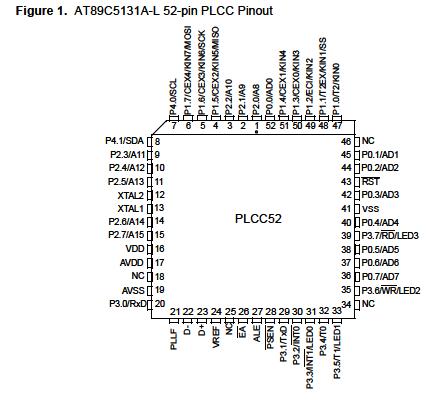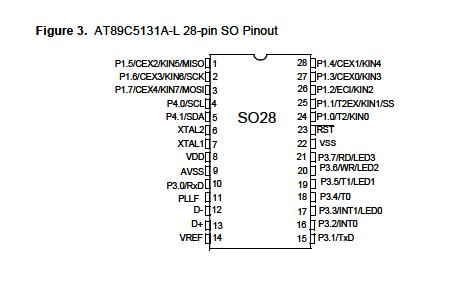Features: • 80C52X2 Core (6 Clocks per Instruction) Maximum Core Frequency 48 MHz in X1 Mode, 24 MHz in X2 Mode Dual Data Pointer
Full-duplex Enhanced UART (EUART) Three 16-bit Timer/Counters: T0, T1 and T2 256 Bytes of Scratchpad RAM
• 16/32-Kbyte On-chip Flash EEPROM In-System Programming through USB Byte and Page (128 bytes) Erase and Write 100k Write Cycles
• 3-KbyteFlash EEPROM for Bootloader Byte and Page (128 bytes) Erase and Write 100k Write Cycles
• 1-Kbyte EEPROM Data ( Byte and Page (128 bytes) Erase and Write 100k Write Cycles
• On-chip Expanded RAM (ERAM): 1024 Bytes
• Integrated Power Monitor (POR/PFD) to Supervise Internal Power Supply
• USB 1.1 and 2.0 Full Speed Compliant Module with Interrupt on Transfer Completion Endpoint 0 for Control Transfers: 32-byte FIFO 6 Programmable Endpoints with In or Out Directions and with Bulk, Interrupt or Isochronous Transfers
• Endpoint 1, 2, 3: 32-byte FIFO
• Endpoint 4, 5: 2 x 64-byte FIFO with Double Buffering (Ping-pong Mode)
• Endpoint 6: 2 x 512-byte FIFO with Double Buffering (Ping-pong Mode) Suspend/Resume Interrupts Power-on Reset and USB Bus Reset 48 MHz DPLL for Full-speed Bus Operation USB Bus Disconnection on Microcontroller Request
• 5 Channels Programmable Counter Array (PCA) with 16-bit Counter, High-speed
Output, Compare/Capture, PWM and Watchdog Timer Capabilities
• Programmable Hardware Watchdog Timer (One-time Enabled with Reset-out): 50 ms to 6s at 4 MHz
• Keyboard Interrupt Interface on Port P1 (8 Bits)
• TWI (Two Wire Interface) 400Kbit/s
• SPI Interface (Master/Slave Mode)
• 34 I/O Pins
• 4 Direct-drive LED Outputs with Programmable Current Sources: 2-6-10 mA Typical
• 4-level Priority Interrupt System (11 sources)
• Idle and Power-down Modes
• 0 to 32 MHz On-chip Oscillator with Analog PLL for 48 MHz Synthesis
• Industrial Temperature Range
• Low Voltage Range Supply: 2.7V to 3.6V (3.0V to 3.6V required for USB)
• Packages: SO28, PLCC52, VQFP64ApplicationAll the external components described in the figure below must be implemented as close as possible from the microcontroller package.
The following figure represents the typical wiring schematicPinout
 SpecificationsI = industrial .........................................................-40°C to 85°C
SpecificationsI = industrial .........................................................-40°C to 85°C
Storage Temperature ..................................... -65°C to + 150°C
Voltage on VCC from VSS.......................................... -0.5V to + 6V
Voltage on Any Pin from VSS ......................... -0.5V to VCC + 0.2VDescriptionAT89C5131A-L is a high-performance Flash version of the 80C51 single-chip 8-bit microcontrollers with full speed USB functions.
AT89C5131A-L features a full-speed USB module compatible with the USB specifications Version 1.1 and 2.0. This module integrates the USB transceivers with a 3.3V voltage regulator and the Serial Interface Engine (SIE) with Digital Phase Locked Loop and 48 MHz clock recovery. USB Event detection logic (Reset and Suspend/Resume) and FIFO buffers supporting the mandatory control Endpoint (EP0) and up to 6 versatile Endpoints (EP1/EP2/EP3/EP4/EP5/EP6) with minimum software overhead are also part of the USB module.
AT89C5131A-L retains the features of the Atmel 80C52 with extended Flash capacity(32-Kbyte), 256 bytes of internal RAM, a 4-level interrupt system, two 16-bit timer/counters (T0/T1), a full duplex enhanced UART (EUART) and an on-chip oscillator.
In addition, AT89C5131A-L has an on-chip expanded RAM of 1024 bytes (ERAM), a dual- data pointer, a 16-bit up/down Timer (T2), a Programmable Counter Array (PCA), up to 4 programmable LED current sources, a programmable hardware watchdog and a power-on reset.
AT89C5131A-L has two software-selectable modes of reduced activity for further reduction in power consumption. In the idle mode the CPU is frozen while the timers, the serial ports and the interrupt system are still operating. In the power-down mode the RAM is saved, the peripheral clock is frozen, but the device has full wake-up capability through USB events or external interrupts.

 AT89C5131A-L Data Sheet
AT89C5131A-L Data Sheet








